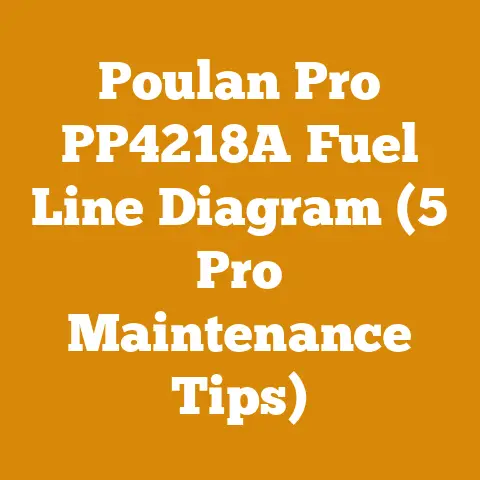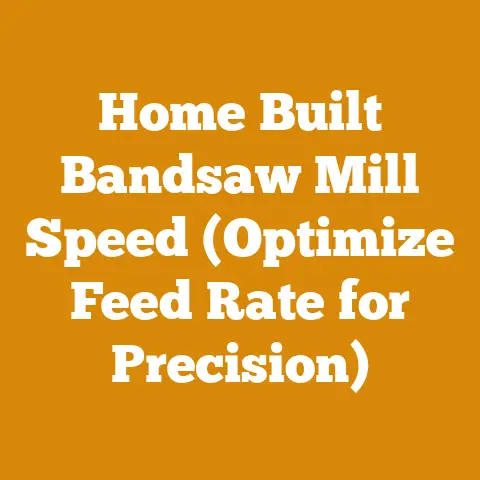Wood and Oil Furnace: Choosing Flue Size Tips (Pro Installer Guide)
Let’s dive deep into the heart of sustainable heating!
Wood and Oil Furnace: Choosing Flue Size Tips (Pro Installer Guide)
As someone who’s spent years wrestling with chainsaws, coaxing warmth from stubborn logs, and generally making friends with the forest, I’ve learned a thing or two about efficient wood heating.
And believe me, nothing’s more frustrating than investing in a wood or oil furnace only to discover the flue size is all wrong.
It’s like trying to run a marathon with shoes two sizes too small – you’re just setting yourself up for a world of pain.
In this guide, I’ll walk you through the crucial process of selecting the correct flue size for your wood or oil furnace.
This isn’t just about efficiency; it’s about safety, longevity of your equipment, and contributing to a more sustainable future.
We’ll cover the theory, the calculations, the common pitfalls, and everything else you need to know to get it right the first time.
Sustainability: The Heart of Efficient Heating
Before we get bogged down in technical specifications, let’s take a moment to appreciate the bigger picture.
Wood, when harvested responsibly, is a renewable resource.
Unlike fossil fuels, it can be replenished, making it a more sustainable heating option.
According to the U.S.
Energy Information Administration (EIA), wood accounts for a small but significant portion of residential heating, especially in rural areas.
However, inefficient wood burning contributes to air pollution.
Proper flue sizing is a critical component of efficient combustion, reducing emissions and maximizing the heat extracted from each log.
Globally, the trend towards sustainable heating is growing.
In Europe, for example, many countries offer incentives for homeowners to switch to biomass heating systems, including wood and pellet stoves.
These systems often have strict emission standards, further emphasizing the importance of correct installation practices.
My own journey with wood heating started with a simple desire to reduce my reliance on fossil fuels.
I lived in a drafty old farmhouse, and the oil bills were crippling.
I decided to install a wood stove, but I made a rookie mistake – I underestimated the importance of flue sizing.
The result?
A smoky house, inefficient heating, and a constant worry about chimney fires.
That experience taught me a valuable lesson, and it’s one I want to share with you.
Understanding the Basics: What is a Flue and Why Does Size Matter?
A flue is the channel or pipe that carries exhaust gases from your furnace or stove to the outside atmosphere.
Think of it as the exhaust system for your heating appliance.
The size of the flue – its diameter and height – is crucial for several reasons:
- Draft: The flue creates a draft, which is the flow of air that pulls combustion gases up and out of the chimney.
An undersized flue can restrict airflow, leading to incomplete combustion, backdrafting (where smoke enters the house), and carbon monoxide poisoning.
An oversized flue can cool the exhaust gases too quickly, causing condensation and creosote buildup, which is a fire hazard. - Combustion Efficiency: A properly sized flue ensures that your furnace or stove burns fuel efficiently.
This means you get more heat from each log or gallon of oil, reducing your fuel consumption and saving you money. - Safety: A properly sized flue helps prevent dangerous conditions like carbon monoxide poisoning and chimney fires.
It also ensures that exhaust gases are vented safely away from your home. - Equipment Longevity: Inefficient combustion can lead to corrosion and damage to your furnace or stove.
A properly sized flue helps prolong the lifespan of your heating appliance.
Key Concepts:
- Green Wood vs.
Seasoned Wood: Green wood has a high moisture content (often above 50%), making it difficult to burn and producing more smoke.
Seasoned wood has been dried for at least six months to a year, reducing the moisture content to 20% or less.
Seasoned wood burns hotter, cleaner, and more efficiently. - Creosote: Creosote is a black, tar-like substance that forms when wood smoke condenses in the chimney.
It’s highly flammable and a major cause of chimney fires. - Draft: The negative pressure in the flue that pulls combustion gases upward.
- Backdrafting: When the draft reverses, causing smoke and combustion gases to enter the house.
Global Context: Firewood Use and Air Quality
Firewood remains a significant heating source globally, especially in developing countries.
However, inefficient burning practices contribute significantly to air pollution, impacting public health.
According to the World Health Organization (WHO), household air pollution from solid fuel burning (including firewood) causes millions of premature deaths each year, primarily due to respiratory infections and cardiovascular diseases.
In developed countries, regulations and incentives are driving the adoption of cleaner-burning wood stoves and furnaces.
Many regions have banned or restricted the use of older, less efficient appliances.
This underscores the importance of understanding and implementing best practices for wood heating, including proper flue sizing.
Step-by-Step Guide to Choosing the Right Flue Size
Okay, let’s get down to the nitty-gritty.
Choosing the right flue size involves several steps:
Step 1: Determine Your Furnace’s Requirements
The first step is to consult your furnace’s manufacturer specifications.
This is the most important step, as the manufacturer will have specific recommendations for flue size.
Look for the following information in the owner’s manual or on the furnace’s nameplate:
- Flue Diameter: The recommended diameter of the flue pipe.
This is usually expressed in inches (e.g., 6-inch flue). - Flue Height: The minimum and maximum recommended height of the chimney.
This is usually expressed in feet (e.g., 12-foot minimum, 25-foot maximum). - BTU Input: The British Thermal Unit (BTU) input of the furnace.
This is a measure of the furnace’s heating capacity. - Fuel Type: Whether the furnace is designed for wood, oil, or both.
Example:
Let’s say you have a wood furnace with the following specifications:
- Flue Diameter: 6 inches
- Flue Height: 15 feet minimum, 20 feet maximum
- BTU Input: 100,000 BTU
- Fuel Type: Wood
Step 2: Understanding Flue Pipe Materials
Flue pipes come in various materials, each with its own advantages and disadvantages:
- Single-Wall Steel: This is the least expensive option, but it’s also the least efficient.
Single-wall pipes cool down quickly, leading to increased creosote buildup.
They are generally not recommended for wood furnaces.
They are often used for connecting the appliance to the chimney (the “connector pipe”). - Double-Wall Steel: This type of pipe has two layers of steel with insulation in between.
It’s more efficient than single-wall pipe and reduces creosote buildup.
It’s a good option for connector pipes, especially if they run through unheated spaces. - Insulated Chimney Pipe (Triple-Wall): This is the most efficient and safest option.
It has three layers of steel with insulation in between, providing excellent heat retention and minimizing creosote buildup.
It’s the recommended choice for the entire chimney system, especially for wood furnaces. - Masonry Chimney: A traditional chimney built from brick or stone.
Masonry chimneys can be used with wood and oil furnaces, but they must be properly lined with a stainless steel flue liner to prevent corrosion and creosote buildup.
Important Note: Always use the correct type of flue pipe for your furnace and fuel type.
Using the wrong type of pipe can be dangerous and void your warranty.
Step 3: Calculating Flue Size (For Oil Furnaces)
While wood furnaces typically have specific flue size recommendations, oil furnaces offer more flexibility.
You can use a calculation to determine the appropriate flue size based on the furnace’s BTU input.
Here’s a simplified formula for calculating flue size for oil furnaces:
Flue Area (square inches) = (BTU Input / 1,000) x 0.06
Once you have the flue area, you can calculate the flue diameter using the following formula:
Flue Diameter (inches) = √(Flue Area / π) x 2
Where π (pi) is approximately 3.14159.
Example:
Let’s say you have an oil furnace with a BTU input of 150,000 BTU.
- Calculate Flue Area: (150,000 / 1,000) x 0.06 = 9 square inches
- Calculate Flue Diameter: √(9 / 3.14159) x 2 = 3.39 inches
In this case, you would need a flue with a diameter of at least 3.39 inches.
Since flue pipes typically come in standard sizes (e.g., 4 inches, 5 inches, 6 inches), you would round up to the next available size, which would be 4 inches.
Important Considerations for Oil Furnaces:
- Altitude: At higher altitudes, the air is thinner, which can affect combustion efficiency.
You may need to increase the flue size slightly if you live at a high altitude.
Consult with a qualified HVAC technician for guidance. - Flue Height: The height of the chimney also affects draft.
A taller chimney will generally create a stronger draft. - Horizontal Runs: Avoid long horizontal runs of flue pipe, as they can restrict airflow and increase creosote buildup.
If a horizontal run is unavoidable, make sure it slopes upward towards the chimney.
Step 4: Calculating Flue Height
Flue height is just as important as flue diameter.
The height of the chimney affects the draft and the dispersal of exhaust gases.
Here are some general guidelines for flue height:
- Minimum Height: The chimney should extend at least 3 feet above the highest point where it exits the roof.
- 2-Foot Rule: The chimney should also extend at least 2 feet higher than any part of the building within a 10-foot radius.
Example:
Imagine your chimney exits the roof near a dormer window.
The dormer window is 5 feet higher than the chimney exit point.
In this case, your chimney would need to extend at least 3 feet above the dormer window to meet the minimum height requirement.
Important Considerations for Flue Height:
- Wind Exposure: If your home is located in a windy area, you may need to increase the flue height to prevent downdrafts.
- Surrounding Obstructions: Tall trees or buildings near your home can also affect the draft.
You may need to increase the flue height to overcome these obstructions. - Local Codes: Check your local building codes for specific requirements regarding flue height.
Step 5: Choosing the Right Chimney Liner (For Masonry Chimneys)
If you’re using a masonry chimney, it’s essential to install a chimney liner.
A chimney liner is a metal or ceramic tube that runs inside the masonry chimney, protecting it from corrosion and creosote buildup.
Types of Chimney Liners:
- Stainless Steel: The most common and durable type of chimney liner.
Stainless steel liners are resistant to corrosion and can withstand high temperatures. - Aluminum: Less expensive than stainless steel, but also less durable.
Aluminum liners are suitable for gas appliances but should not be used with wood or oil furnaces. - Ceramic: A traditional type of chimney liner that’s resistant to corrosion and high temperatures.
Ceramic liners are more expensive than stainless steel and require professional installation.
Sizing the Chimney Liner:
The chimney liner should be the same size as the flue pipe recommended by the furnace manufacturer.
If the chimney is larger than the flue liner, you’ll need to insulate the space between the liner and the chimney to prevent condensation and creosote buildup.
Step 6: Installation Best Practices
Proper installation is crucial for ensuring the safety and efficiency of your heating system.
Here are some best practices to follow:
- Follow Manufacturer Instructions: Always follow the manufacturer’s instructions for installing the flue pipe and chimney liner.
- Use the Correct Fittings: Use the correct fittings to connect the flue pipe to the furnace and the chimney.
- Seal All Connections: Seal all connections with high-temperature sealant to prevent leaks.
- Maintain Proper Clearance: Maintain the proper clearance between the flue pipe and combustible materials, such as wood framing.
Check local codes for specific clearance requirements. - Inspect Regularly: Inspect the flue pipe and chimney regularly for signs of damage or creosote buildup.
- Hire a Professional: If you’re not comfortable installing the flue pipe or chimney liner yourself, hire a qualified HVAC technician.
Step 7: Troubleshooting Common Problems
Even with careful planning and installation, you may encounter problems with your flue system.
Here are some common issues and how to troubleshoot them:
- Smoky House: This could be caused by an undersized flue, a blocked chimney, a downdraft, or burning green wood.
- Solution: Check the flue size, clean the chimney, increase the flue height, or switch to seasoned wood.
- Creosote Buildup: This is a common problem with wood-burning appliances.
- Solution: Burn seasoned wood, clean the chimney regularly, and ensure proper draft.
- Backdrafting: This is a dangerous condition where smoke enters the house.
- Solution: Check the flue size, ensure proper draft, and install a carbon monoxide detector.
- Corrosion: This can occur in masonry chimneys due to acidic combustion gases.
- Solution: Install a stainless steel chimney liner.
Data-Backed Insights: Wood Species and Firewood Quality
The type of wood you burn significantly impacts the efficiency and cleanliness of your heating system.
Different wood species have different densities, moisture content, and burning characteristics.
Here’s a comparison of some common firewood species:
Key Takeaways:
- Oak: A dense hardwood that burns long and hot with minimal smoke.
It requires a longer drying time. - Maple: A good all-around firewood that burns well and dries relatively quickly.
- Birch: Burns well but produces more smoke than oak or maple.
The bark is flammable and can be used as a fire starter. - Pine: Burns hot and fast, but produces a lot of smoke and sparks.
It’s best used for kindling or starting fires. - Poplar/Aspen: A low-density wood that burns quickly and produces a lot of smoke.
It’s not ideal for firewood.
Data Point: A study by the University of Maine found that burning seasoned hardwood (oak or maple) can reduce particulate emissions by up to 50% compared to burning green softwood (pine or poplar).
Tool Selection: Chainsaws vs. Each tool has its own advantages and disadvantages:
Chainsaw:
- Advantages: Faster and more efficient for cutting large logs. Requires less physical effort.
- Disadvantages: More dangerous than an axe. Requires more maintenance. More expensive.
Axe:
- Advantages: Safer than a chainsaw. Requires less maintenance. Less expensive. Good exercise.
- Disadvantages: Slower and more physically demanding than a chainsaw.
Less efficient for cutting large logs.
My Recommendation: For most people, a combination of both tools is the best approach.
Use a chainsaw to cut large logs into smaller pieces, and then use an axe or splitting maul to split the logs into firewood.
Case Study: Optimizing Firewood Drying
I once worked with a small firewood producer who was struggling to meet demand.
Their firewood was consistently damp, leading to complaints from customers.
After analyzing their operation, I identified the problem: they were not properly seasoning their wood.
We implemented a new drying strategy that involved:
- Stacking the Wood Properly: We stacked the firewood in long, narrow rows, with plenty of space between the rows for air circulation.
- Elevating the Wood: We elevated the wood off the ground using pallets to prevent moisture from wicking up from the soil.
- Covering the Wood: We covered the top of the woodpile with a tarp to protect it from rain and snow, but left the sides open for ventilation.
The results were dramatic.
Within six months, the moisture content of the firewood had dropped significantly, and customers were much happier with the quality of the wood.
The firewood producer was able to increase their sales and profitability.
Data Point: Research from the Forest Products Laboratory shows that properly stacked and seasoned firewood can dry to a moisture content of 20% or less in six to twelve months, depending on the climate and wood species.
Costs, Budgeting, and Resource Management
Setting up a wood heating system involves several costs, including:
- Furnace or Stove: The cost of the furnace or stove itself can range from a few hundred dollars to several thousand dollars, depending on the size, efficiency, and features.
- Flue Pipe and Chimney Liner: The cost of the flue pipe and chimney liner will depend on the material and length required.
Expect to spend several hundred dollars to over a thousand dollars. - Installation: Professional installation can cost several hundred dollars to over a thousand dollars, depending on the complexity of the job.
- Firewood: The cost of firewood will depend on the availability in your area and whether you buy it or harvest it yourself.
- Tools: If you plan to harvest your own firewood, you’ll need to invest in tools like a chainsaw, axe, splitting maul, and safety equipment.
Budgeting Tips:
- Get Multiple Quotes: Get quotes from several HVAC technicians before hiring someone to install your heating system.
- Shop Around for Firewood: Compare prices from different firewood suppliers.
- Consider Harvesting Your Own Firewood: If you have access to a woodlot, harvesting your own firewood can save you money.
- Look for Rebates and Incentives: Check with your local utility company and government agencies for rebates and incentives for installing energy-efficient heating systems.
Resource Management Tips:
- Harvest Wood Sustainably: If you harvest your own firewood, make sure to do so sustainably.
Avoid cutting down healthy trees and focus on dead or dying trees. - Season Firewood Properly: Season firewood for at least six months to a year before burning it.
- Store Firewood Properly: Store firewood in a dry, well-ventilated area.
- Maintain Your Equipment: Regularly maintain your furnace or stove and your tools to ensure they are operating efficiently and safely.
Common Pitfalls to Avoid
- Underestimating the Importance of Flue Size: This is the most common mistake people make when installing a wood or oil furnace.
- Using the Wrong Type of Flue Pipe: Using the wrong type of flue pipe can be dangerous and void your warranty.
- Improper Installation: Improper installation can lead to safety hazards and inefficient heating.
- Burning Green Wood: Burning green wood produces more smoke and creosote than burning seasoned wood.
- Neglecting Maintenance: Neglecting maintenance can lead to equipment failure and safety hazards.
Next Steps and Additional Resources
- Consult with a Qualified HVAC Technician: A qualified HVAC technician can help you choose the right furnace and flue size for your home and install it safely and efficiently.
- Contact Your Local Building Department: Your local building department can provide information on building codes and regulations related to wood and oil heating systems.
- Visit the EPA Website: The Environmental Protection Agency (EPA) website has information on wood stove regulations and best practices for wood heating.
- Check with Your Local Utility Company: Your local utility company may offer rebates and incentives for installing energy-efficient heating systems.
- Attend a Firewood Workshop: Many organizations offer workshops on firewood preparation and wood heating safety.
Suppliers of Logging Tools and Drying Equipment Rental Services:
- Northern Tool + Equipment: Offers a wide range of logging tools, including chainsaws, axes, and splitting mauls.
- Bailey’s: Specializes in logging and forestry equipment, including chainsaws, protective gear, and winches.
- Sunbelt Rentals: Offers drying equipment rental services, including dehumidifiers and air movers.
- United Rentals: Another option for drying equipment rental services.
Final Thoughts: Staying Warm Responsibly
Choosing the right flue size for your wood or oil furnace is an essential step towards creating a safe, efficient, and sustainable heating system.
By following the steps outlined in this guide, you can ensure that your furnace operates at peak performance, reducing your fuel consumption, minimizing emissions, and keeping your home warm and comfortable for years to come.
Remember, responsible wood heating is not just about keeping warm; it’s about protecting our environment and ensuring a sustainable future for generations to come.
So, grab your chainsaw, sharpen your axe, and get ready to embrace the warmth of wood, knowing you’re doing it the right way!






